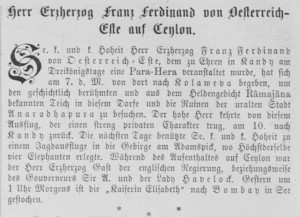I had asked to visit an Indian prison. A wish that was granted most willingly by offering me the opportunity to visit a prison in the south of Delhi. We passed the Delhi gate, one of ten gates which are set in the 8,8 km long ring wall around the city. After a short ride through the field of ruins of old Delhi we arrived in front of the prison occupied by around 500 prisoners.
By a double lock gate which is comparable to a double wall we entered the interior and saw something like a formal city quarter of small ground floor buildings intended for housing the prisoners who are separated from each other so that no communication can take place among them while they are under precise supervision from certain central locations.
Generally it is the practice of keeping prisoners isolated for some time to get to know them, I might say, to study their character. In the individual cell the prisoner has to work, namely he has to fulfil a daily quota of grinding corn in a primitive way with two millstones and their hands. Is he behaving well, he enters into a group cell and work. In the opposite case or if it is clear that the prisoner has a negative influence on his fellow prisoners, he will have to spend all his time in individual cells. Especially hard criminals and those who have escaped before are shackled with heavy iron bars on their feet and kept almost like wild beast in open iron cages on whose end is found a cell with an open hard bed. In one of those cells sat an old man who has broken out already thrice. He devised means to cut the thick iron bars — using wool threads and a mixture of oil, sand and glass splinters which he managed to procure. He rubbed a part of the iron bar for so long until he had worn it out and he could escape. Probably one of the greatest exercises in perseverance! Twice he was successful but the third time he has been caught. Another prisoner had built a key out of discarded lead within three months. But the artful tool has been discovered at the latest moment. An especially wild impression made two Afghans one of which was accused of murder. The other had been sentenced to 37 years of hard labor for a similar crime.
The individual cells contain a bed made out of clay with a stray mat and two covers. The rest of the equipment is a cup and the already mentioned millstone.
One part is reserved for boys among which one can see true rascals. Another part is for habitual criminals who have entered this holy halls repeatedly. A third part, finally, is for women among whom are a number of truly ugly and depraved ones.
The prisoners‘ dress is uniform: It consists of a covering cloth worn over a piece of linen wrapped around the middle of the body. To eat they receive from our point of view a very small ration of two flat unleavened breads in the morning plus one eighth of a liter Dal (a type of bean) with butter and condiments, at noon a handfull of roasted wheat and in the evening green vegetables with two breads. And still the prisoners are well and look good.
According to the opinion of the prison director the only fault of the prison is treating the prisoners better than their life would be outside. Laments such as those made by the director can be heard also at home where comparisons are often made between the nice life in prison even for hard criminals compared to the life existence of our soldiers in their barracks. I can not really find fault that the humane treatment of hard criminals has gone too far and has lessened the impact of punishment.
I inspected all workshops where the prisoners execute tasks together with the simplest of tools. They produce cartonnage and earthenware, rugs and mats made out of reeds which grows near all rivers. I ordered a great number for the corridors of Konopiste. Their own clothing has to be produced by the prisoners themselves too.
After my return to the city, valuable time was lost in my misleading visiting the city museum of the institute which is in a desolate condition and stood next to Chandni Chowk street. It is difficult to present an overview of all the dirt, the overwhelming desolation an mixture of the motley mammals, birds, cloths, household items and other ethnographic objects. At least one could learn to see what a museum should not look like.
On revient toujours … also once again paid a visit to Tellery to do some shopping, namely rugs.
Then we watched cock fights organized by natives in out hotel. As cruel this entertainment may be, it isn’t without attraction: with astonishing bravery and combativeness, even rage, the two brave roosters hit one another with beaks and spurs until one of them succumbed.
In the evening the train took us to Alwar, Northwest of Agra, Southwest of Delhi, which lies on the Rajputana-Malwa Railway including Bombay, Baroda and Central India Railway that runs by the way of Ahmedabad to Bombay.
Links
- Location: Alwar, India
- ANNO – on 18.02.1893 in Austria’s newspapers. The newspapers are gearing up to Pope Leo XIII’s 50th anniversary of consecration as a bishop (and 15th anniversary as pope) on 19th February.
- The k.u.k. Hof-Burgtheater is playing a comedy „Verbot und Befehl“, while the k.u.k. Hof-Operntheater is performing Jules Massenet’s „Manon“.
